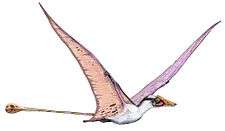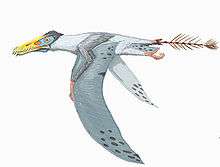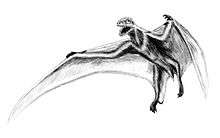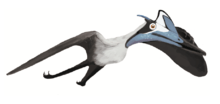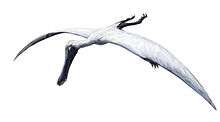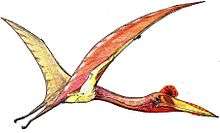Huaxiapterus
Huaxiapterus (meaning "Hua Xia [China] wing") is a genus of tapejarid pterodactyloid pterosaur from the Aptian-age Lower Cretaceous Jiufotang Formation of Chaoyang, Liaoning, China. It is the second genus of tapejarid from this formation, after Sinopterus. Three species are known, though they may not actually form a natural group with each other. It was first named by Lü Junchang and Yuan Chongxi.
| Huaxiapterus | |
|---|---|
 | |
| Fossil specimen, Beijing Museum of Natural History | |
| Scientific classification | |
| Kingdom: | Animalia |
| Phylum: | Chordata |
| Order: | †Pterosauria |
| Suborder: | †Pterodactyloidea |
| Family: | †Tapejaridae |
| Subfamily: | †Sinopterinae |
| Genus: | †Huaxiapterus Lü & Yuan, 2005 |
| Species | |
| |
Discovery
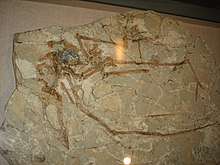
The type species of Huaxiapterus is H. jii, is based on GMN-03-11-001, a nearly complete skeleton and skull.[1] While it was initially separated from the closely related Sinopterus by several characters including its larger size and larger crest, later studies showed that it was in fact more closely related to Sinopterus dongi than to either of the other two species of Huaxiapterus.[2] Some researchers have considered H. jii to be a species of Sinopterus for this reason, though a more thorough analysis has suggested it is slightly more primitive than Sinopterus.[3]
The second species, "H." corollatus, is based on ZMNH M8131, another nearly complete skeleton from the same formation.[4] The third species "H." benxiensis, based on specimen BXGM V0011, also comes from Liaoning.[5] Because H. jii is the type species of its genus, and the other two species are not closely related to it, they will likely be renamed in the future.[6]
An additional species, H. atavismus, was named in 2016 based on a small specimen XHPM 1009. It can be distinguished from other species by a groove on the second and third wing digits, a trait that is otherwise only known in the more basal rhamphorhynchoid pterosaurs; it was named after this trait, which appears to be an atavism (or "evolutionary throwback").[7]
Classification
The cladogram below follows the 2014 analysis Andres and colleagues.[3]
| Azhdarchoidea |
| ||||||||||||||||||||||||||||||||||||||||||||||||||||||||||||||||||||||||||||||
References
- Lü, J.; Yuan, C. (2005). "New tapejarid pterosaur from Western Liaoning, China". Acta Geologica Sinica. 79 (4): 453–458. doi:10.1111/j.1755-6724.2005.tb00911.x.
- Kellner, A.W.A.; Campos, D.A. (2007). "Short note on the ingroup relationships of the Tapejaridae (Pterosauria, Pterodactyloidea)". Boletim do Museu Nacional. 75: 1–14.
- Andres, B.; Clark, J.; Xu, X. (2014). "The Earliest Pterodactyloid and the Origin of the Group". Current Biology. 24 (9): 1011–6. doi:10.1016/j.cub.2014.03.030. PMID 24768054.
- Lü, J.; Jin, X.; Unwin, D.M.; Zhao, L.; Azuma, Y.; Ji, Q. (2006). "A new species of Huaxiapterus (Pterosauria: Pterodactyloidea) from the Lower Cretaceous of western Liaoning, China with comments on the systematics of tapejarid pterosaurs". Acta Geologica Sinica. 80 (3): 315–326. doi:10.1111/j.1755-6724.2006.tb00251.x.
- Junchang, Lü; Yubo, Gao; Lida, Xing; Zhixin, Li; Zhenyuan, Sun (2007). "New species of Huaxiapterus from the Early Cretaceous of western Liaoning." Acta Geologica Sinica". (English edition). 81 (5): 683–687. doi:10.1111/j.1755-6724.2007.tb00992.x.
- Pinheiro, F.L.; Fortier, D.C.; Schultz, C.L.; De Andrade, J.A.F.G.; Bantim, R.A.M. (2011). "New information on Tupandactylus imperator, with comments on the relationships of Tapejaridae (Pterosauria)". Acta Palaeontologica Polonica. 56: 567–580. doi:10.4202/app.2010.0057.
- Lu, Junchang; Teng, Fangfang; Sun, Deyu; Shen, Caizhi; Li, Guoqing; Gao, Xia; Liu, Hanfeng (2016). "The Toothless Pterosaurs from China". Acta Geologica Sinica. 90 (9): 2513–2525.
External links
- Huaxiapterus in The Pterosauria
- Two reconstructions of Huaxiapterus at The Grave Yard
